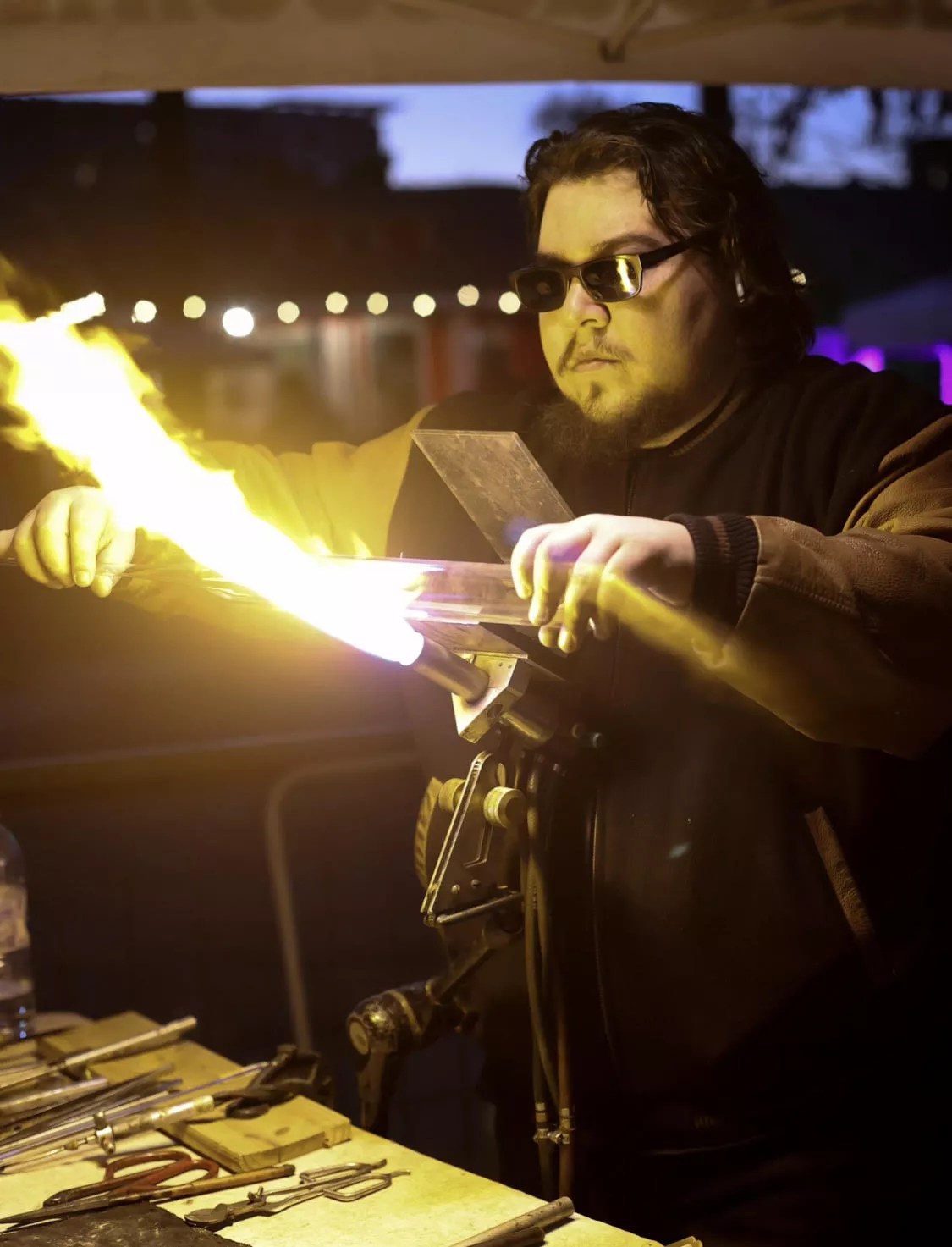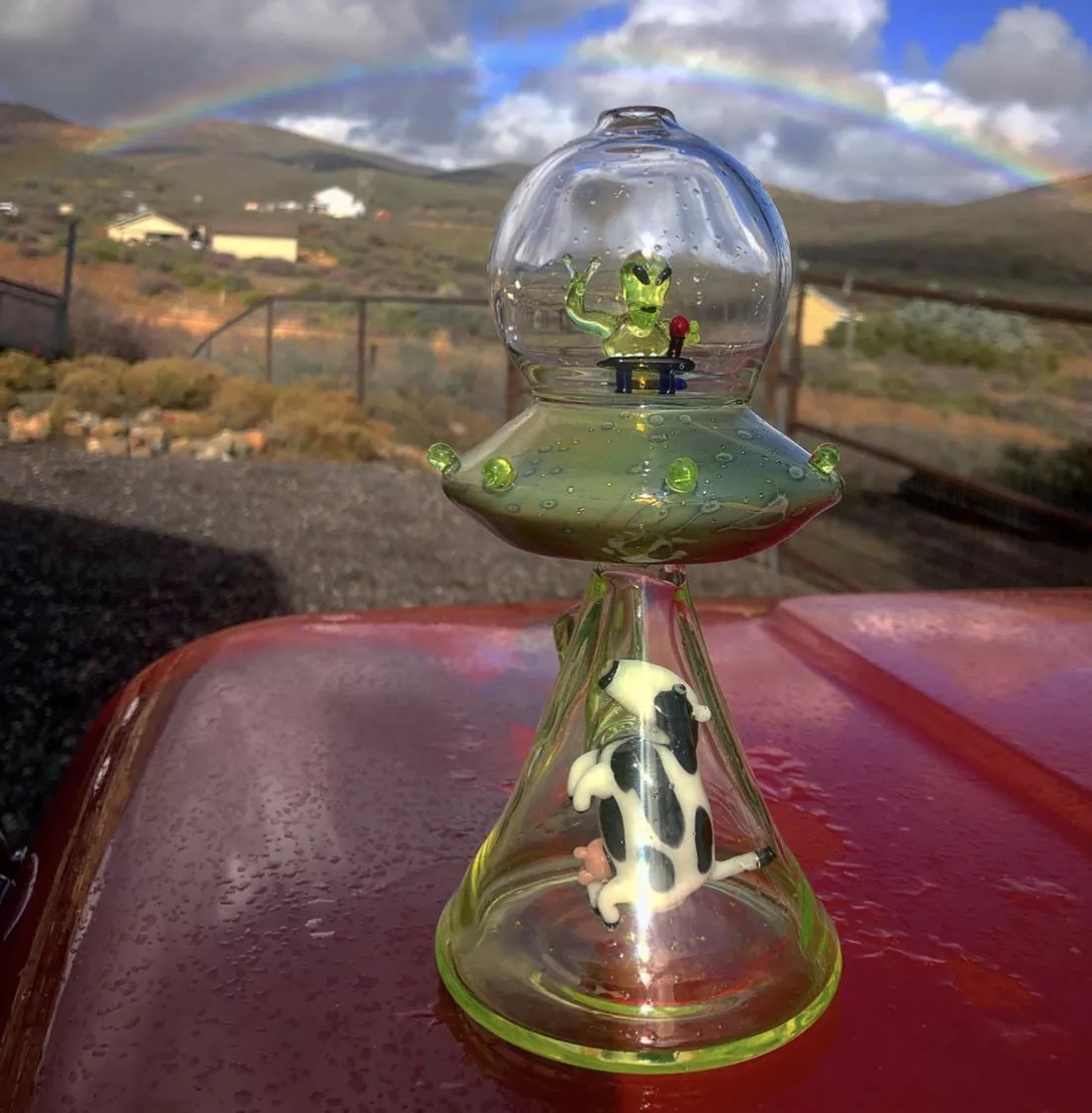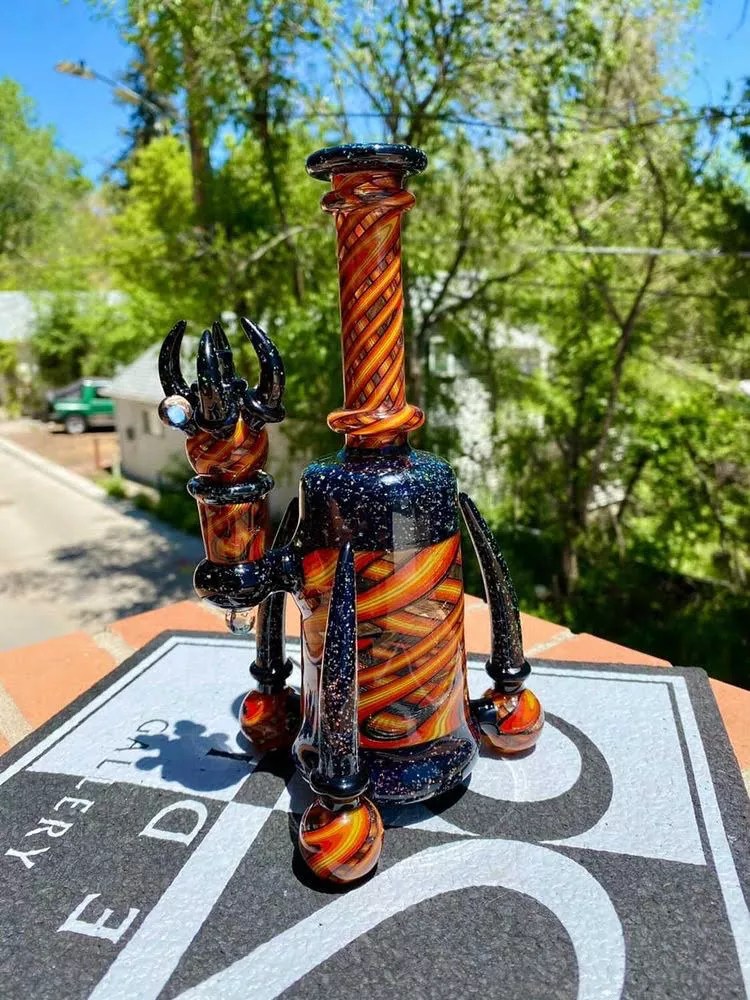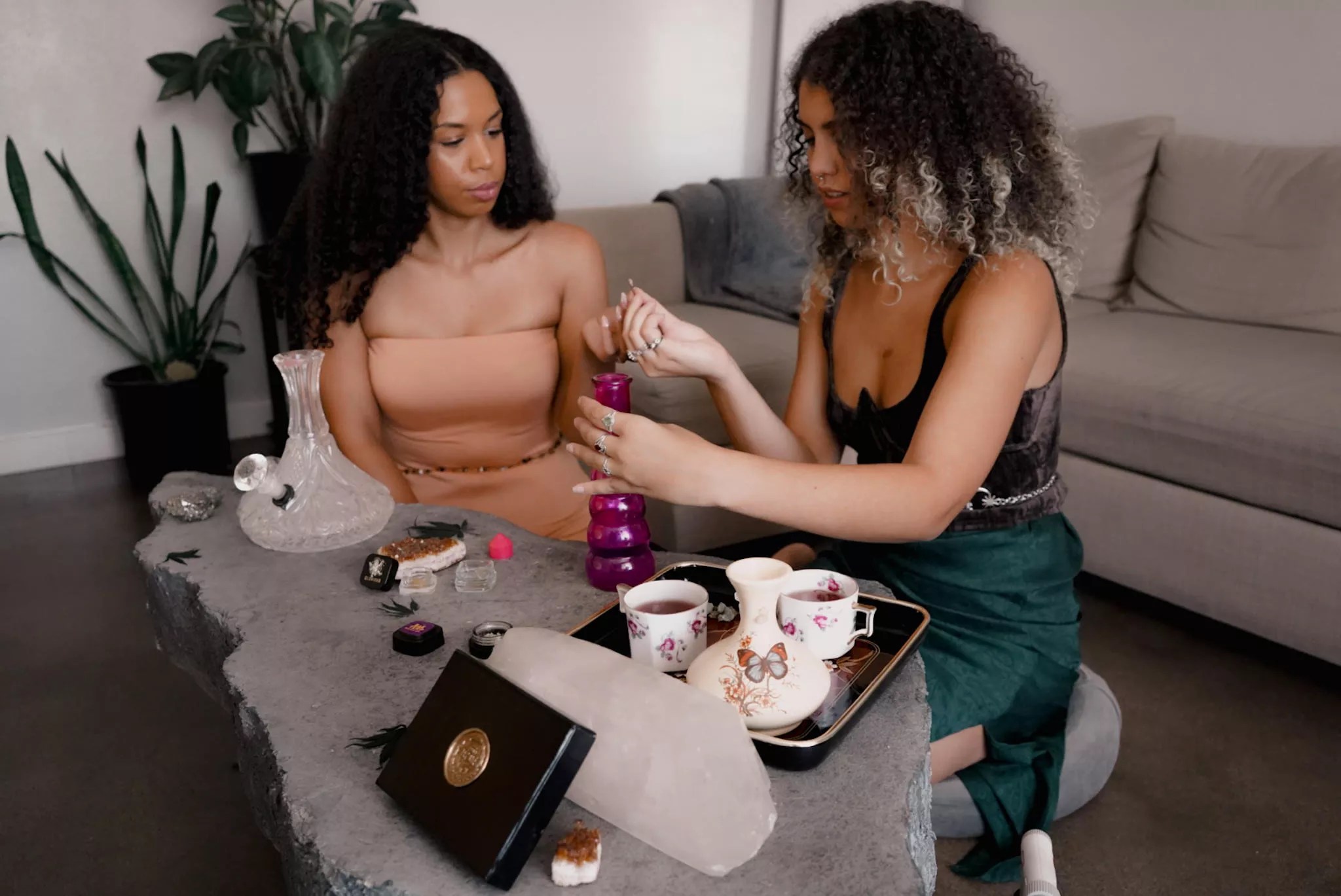
Courtesy of Desi B. Glass

Audio By Carbonatix
Happy 710 Day, metro Phoenix.
For those who aren’t in the know, the date July 10 or 7/10 is a holiday for cannabis consumers, especially those who consume cannabis concentrate, a.k.a. wax, dab – or “OIL.”
“Some folks may not know that 710 backward reads “OIL,” says Erika McKendree, a local cannabis brand ambassador and longtime cannabis user. “To me, 710 is a well-known stoner holiday where users partake in dabs. Cannabis users who enjoy dabs over flower prefer variations of oil because the duration of the high lasts longer than smoking flower buds and is manageable.”
The dabber uses a rig, a vaporizing device that looks like a bong. But the rig is generally smaller than a bong and different because instead of a bowl to place the marijuana, the dabber’s rig has a nail made of quartz, titanium, or similar material that’ll sustain lots of heat. First, the dabber heats the nail with a blowtorch, then utilizes a tool to place the dab of concentrate oil onto the nail. The dabber then inhales the smoke emitted from the dab as it reacts to the hot nail.
Phoenix, make your New Year’s Resolution Count!
We’re $14,000 away from our End-of-Year campaign goal, with just a five days left! We’re ready to deliver — but we need the resources to do it right. If New Times matters to you, please contribute today to help us expand our current events coverage when it’s needed most.
In the last few years, as more people mastered the cannabis extract process of squeezing the oils and THC out of cannabis to create an oil dab for dabbers, the demand for glass rigs increased. And as dabbers’ tastes and quality of high evolved, and their spending on top-shelf concentrates increased, so did their glass rig budget. Some even keep their new cannabis glassware on shelves like fine crystal. As custom glass rigs and bongs grew in demand, the skills of local glassblowers, glassmakers, and glass repurposers evolved.
In honor of 710, Phoenix New Times sought out the “most lit” cannabis glassmakers in the Valley.
Friday Glass

For about ,500, a dabbing collector can purchase Brodsky’s dragon.
Friday Glass
Jake Brodsky from Friday Glass in Chandler has been customizing glass for nearly 10 years; for eight of those years, he’s been creating rigs and bongs. “Most bongs are made using a glass lathe, and the sculpted pieces are traditionally done by hand,” he says. (A lathe is a larger piece of equipment that holds glass tubes in place as they rotate.)
What Brodsky does is called lampworking, a type of glasswork in which a lamp or torch is utilized to liquify the glass. Once the glass is liquified, it is formed by blowing and then shaping by handling (with gloves) and graphite tools that are dense and can sustain high temperatures. He also uses brass carving tools that resemble scalpels.
On Instagram, the 30-year-old artist goes by the @friday_glass handle. His recent posts featuring his latest creations include a glass Homer Simpson character with a doughnut in one hand and a Duff beer in the other. Another piece is what he calls Rasta Skull, a skeleton character with dreadlocks wearing a beanie, a white scarf with fringed endings, and an intricately detailed multicolored striped shirt.
Brodsky explains, “The lines on the shirt are a tubing that is made by placing a smaller tube inside of a larger one that has a 7-millimeter distance between them and is filled with 7-millimeter rods of color to create “lined tubing.” It looks like one solid piece when heated and melded together.
He collaborated with Hendy, another local glass artist, in both of the aforementioned glass sculptures. Artists usually collab to widen their reach as they share their in-person and social media fanbase, but it also brings another artistic dimension into one another’s glass repertoire.
Think of it like building a hot rod show car: The painter laying the candy paint job will bring in a super steady-handed pin-striper, then a paint buffer, and so on.
There’s another collaboration present in Brodsky’s recent glasswork: an homage to artist Stan Sakai’s Miyamoto Usagi character. The piece is a rabbit samurai donning a traditional Japanese hakama (a sword). Lucas (@710swords on Instagram) made a miniature samurai sword to the scale of the 7.5″ glass piece.
Though the colorful creations work as home decor or pieces of art, they’re fully functional for dabbing.
“They have what is called a dewar seal,” Brodsky says, “which is a full recessed joint inside the piece all connected to a down stem to make it function.”
And to give the rigs that detail, the pieces are sculpted separately.
“The separate pieces are all held on a glass tube, usually 12 millimeters in diameter, and the tubing sections are transferred from tube to tube,” Brodsky says. They are then attached and resculpted where necessary. In the case of the sword-wielding rabbit, the pair of open hands with fingers, the martial arts belt ends, and pointy ears held up with a ponytail accent are such evident glassy details.
The pieces, although small, take a full day of work per unit for Brodsky, an average of nine hours.
To cop Homer’s glassy miniature counterpart, it’ll run about $2,000. The rasta skeleton is $1,800 and the samurai rabbits fetch about $1,200.
For about $1,500, a dabbing collector can purchase Brodsky’s dragon, which stands about 6 inches and weighs 3/4 of a pound. Under different lighting, the piece changes color. Like in the other units, Brodsky brought in a collaborator, Steve H Glass, to make a 10-millimeter opal coin marble. It’s a more expensive design because of the collaboration with Steve H.
Besides collabing with different artists, Brodsky shares a studio with fellow glass makers Hendy, Steve H Glass, and heavydruty. They share the place to save money on rent, utilities, tools, and materials when they buy in bulk.
Regarding cannabis consumption, Brodsky prefers to smoke flowers, primarily joints. But he says, “Smoking all day could and has prevented me from getting as much work done as I’d like. So I try to smoke responsibly and according to my plans for the day.”
Desi B. Glass
Desi B. Glass, 30, asked Phoenix New Times to address him by his artist name. He learned much of his glassmaking abilities to the teachers and staff at Mesa Arts Center and been making glass pipes, bongs, and dab rigs for 10 years out of his Phoenix garage that he transformed into a home studio.
Recently, Desi made a special $2,500 Dab Bot rig. Dab Bot is a 7-inch glass rig that resembles a robotic monkey. The rig has lanky arms extended out to hold a bowl that accommodates a ground joint to place the dab or a bowl for the flower. The mouthpiece is jutting from the back of the robot’s head; the robot’s face is adorned with translucent cobalt blue ear accents and eyes. Desi added a gold and silver fume process on top of the cobalt blue glass, adding an iridescent rainbow-ey finish.

The Abduction rig by Desi B. Glass.
Desi B. Glass
“The material I work with is borosilicate glass, which is basically Pyrex,” he explains. “I use a propane and oxygen torch to heat the glass and a kiln to anneal the pieces and keep them hot between steps.” A kiln is a type of oven to hold the custom glass pieces as they slowly cool, dry, and harden.
Desi says he makes cheaper versions of the Dab Bot for about $1,200.
The complexity of glass tubes that frame the out-of-this-world rig’s design dictates much of its price – but more so its functionality. “So the smoke would start in the ground joint between the bot’s hands,” Desi explains. “The smoke will then travel up the arms into the shoulders, down the spine, and into the feet.” Then the smoke travels up through the robot’s body into the head and out of the mouthpiece into the smoker’s lungs.
“When I smoke weed, it helps keep my nerves together when a piece breaks,” Desi says. “But sometimes, you can get too baked and need a break.”
Desi deserves a break after he spends 10 hours creating a robotic monkey rig. Weed provides him with “creativity too,” he says. “The Iron Giant robot sorta inspired the look.”
Mars Attacks!, Tim Burton’s 1996 sci-fi comedy, is another movie that has inspired Desi’s sci-fi bong and rig designs. Enter the Abduction rig, a diorama of sorts in which a glass alien in a spaceship is hovering above a glass cow that’s also hovering. It retails for about $1,500.
“I used Illuminati glass on that,” he says. “It’s sold out right now, so I put that design on pause.” The popular green-colored glass, which makes up most of the Abduction rig, is running short in the Valley’s supply chain. The green glass is used to make the spaceship and its alien pilot who’s throwing up a peace sign. The floating cow is not actually floating. Desi cleverly affixed its tail to the glass but purposely added an udder detail to distract the weed or concentrate oil consumer. Its entirety is encapsulated in a more oversized glass which acts as the rig’s frame and chamber.
Even in the summer, Desi’s still cranking out the Dab Bot rigs. “It’s hot in the Valley, and it’s hotter over the torch,” he says. “But there’s nothing I’d rather be doing than getting to make pipes for the community I love.”
Reverend Morse
James Wilson creates colorful dab rigs in a private studio in Tempe. “I mainly make dab rigs as usually they are preferred to be smaller, allowing them to be easier to make by hand, compared to your average-sized bong, which is mainly made on a lathe,” he says.
Wilson’s latest creations are posted on his Reverend Morse Instagram page, many with psychedelic linear patterns that appear as if the rig is moving in a still photo.
“My go-to technique is linework, using tubing made from different colored rods either stacked around a tube or drawn on,” he explains. “From there, it is heated in certain areas allowing different outcomes such as spinning/swirling.” The 29-year-old glass artist uses Borosilicate glass and a propane and oxygen torch as Desi but uses “graphite paddles and reamers” to shape the glass.

A Reverend Morse rig.
Reverend Morse
“On average, my linework rigs range between $800 and $1,400,” he says. “I also make pendants, marbles, and other smaller items that don’t take as much time and material which would range anywhere from $50 to $250 depending on the technique and amount of work.”
Wilson admits to pulling the highest dollar amount for glass pieces he’s created with other artists. “We would have more time and multiple techniques all in one.”
Unlike the other creators, though, Reverend Morse (Wilson) doesn’t consume cannabis anymore, “which might be rare in my line of work,” he says, because “I was unable to enjoy it like I used to.”
Cherry Eyes Smokeware
Jazmyne Plantillas’ Cherry Eyes Smokeware has a different approach to creating glass rigs and bongs. The 23-year-old Phoenix artist says, “I find my pieces mainly by thrift stores, antique shops, OfferUp, Facebook Marketplace, and even donations. One of my weirdest finds was a vase shaped like a trumpet.”
Unlike the aforementioned glass artists, her tool setup is simple: “a drill, a bit of water, and patience,” she says. “Each piece probably takes at least an hour to process, including searching, cleaning, drilling, soaking, designing, and testing. One of the most difficult parts of the process can be putting the piece itself together, because sometimes the glass I find is thick, so it takes a lot of effort. Sometimes, it will even take me days to get a rubber gasket on a particular piece.”
She loves to work with old decanters, and the more ornate or Victorian-esque the glass, the more she charges. She gets between $80 and $250 for pieces. On her page, she has a white decanter with a chiseled surface that accommodates concentrate. It’s a white Jim Beam milk glass decanter, she explains, to which she added a oval moonstone accent piece.
Another converted decanter that went live on her IG earlier in the year was captioned: “This is the last bong of the Moonstone and Labradorite collection. [It’s a] tall clear decanter bong with three amazing moonstone crystals on three facing sides.” Shortly after, the caption was updated with “SOLD!”
Plantillas continued, “I’ve been making them at home, usually on my patio, for about a year and a half. I make both styles: one is for smoking cannabis flower, and the other is for smoking cannabis concentrates.
“That part on the end that holds the concentrate is called a ‘nail.’ It’s a certain size, 14 millimeters, so it fits easily into the stem. A customer could easily switch that piece for a bowl for flower, they just need a 14mm bowl, which is pretty standard.”

Erika McKendree (left) and Jazmyne Plantillas celebrate 710 day with a Cherry Eyes Smokeware rig.
Instagram: az.mac.gallery
On June 26, Plantillas had a smoke sesh with McKendree, the brand ambassador who broke down 710 Day earlier in the article. McKendree says, “I found out about her (Plantillas’) art last year by seeing many community members supporting her work. I find it extremely important and considerate in today’s climate always to be eco-friendly. I love that she repurposes something once old into something better, inspiring others that they too can discover new methods to become environmentally conscious.”
McKendree then busts out some Round Table Genetics concentrate and flower and places a dab in a newly repurposed pink-colored glass rig. “I found that vase at goodwill,” she said. Finally, the two pulled out a torch lighter and dab, celebrating 710 Day early.
“[Dabbing] helps when making my Smokeware because I can be hunched over while working,” Plantillas says. “Or bending at awkward angles that bring me back and neck tension. That’s just one of the ways cannabis positively impacts my life.”